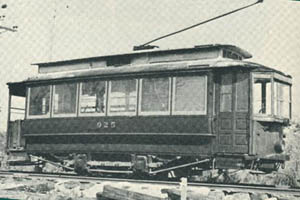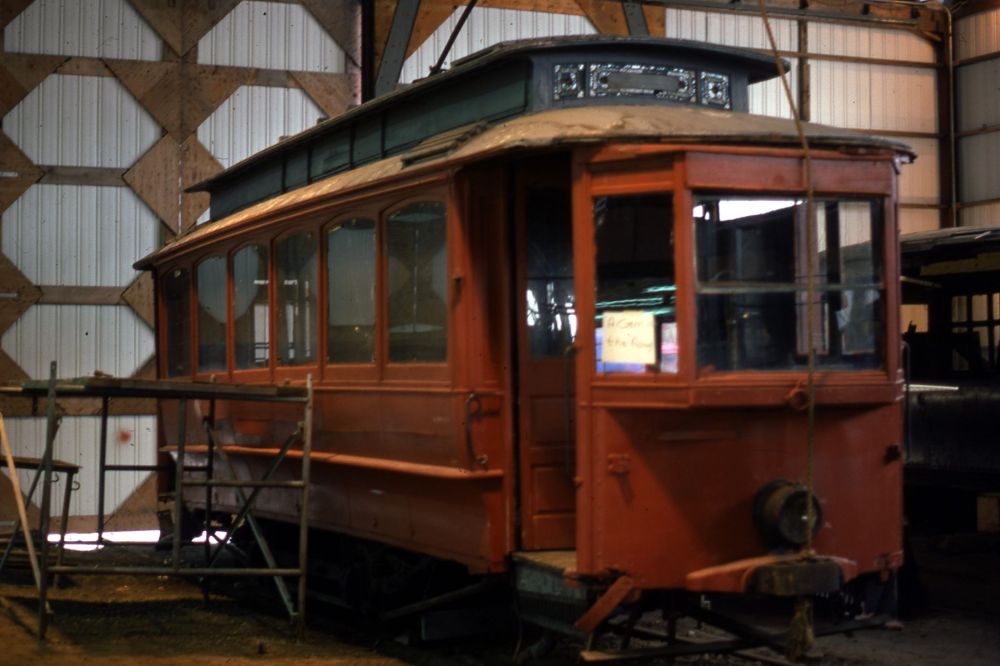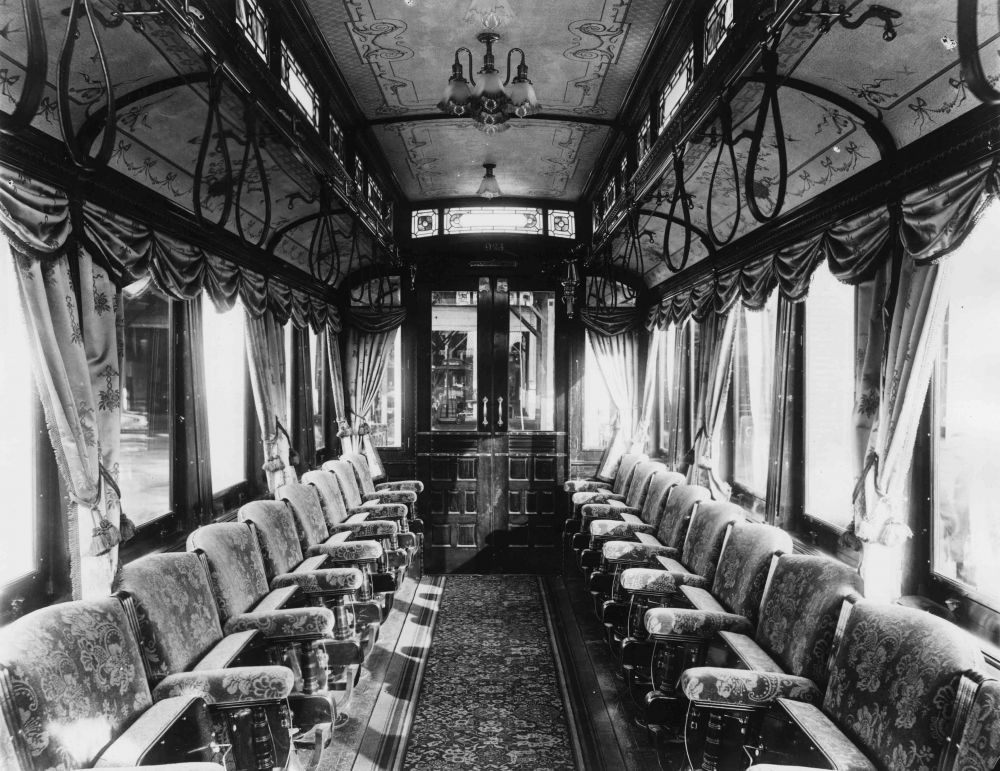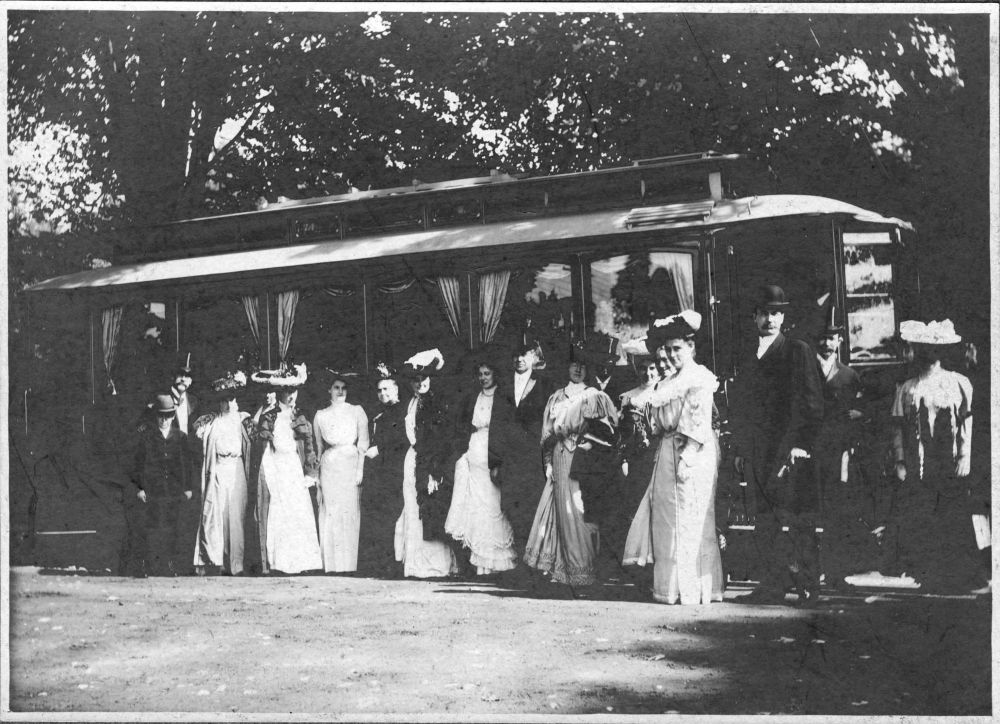
- Builder
- J. M. Jones
- Description
- Parlor car
- Secondary Use
- Railway maintenance
- Type
- City and Suburban Streetcars
- Year
- 1894
- Retired from Service
- 1954
- Acquired by the Museum
- 1954
- Note
- The museum has stored No. 925 in Shop #1 for many years. The former parlor car is still in operating condition but needs work before display or extensive operation.
West End St. Ry. 925
From Boston, Massachusetts
History
Seashore Trolley Museum’s collection of vehicles primarily shows how ordinary people have traveled by public transit. A few museum vehicles, however, provided unusually luxurious travel for transit executives and for customers willing to pay extra for this service. West End Street Railway parlor car No. 925 is one such special streetcar.
The West End Street Railway was the principal Boston-area streetcar operator in the 1890s and is the direct ancestor of today’s MBTA. Early in 1894, the West End Street Railway decided to provide some luxury service for its patrons, and on March 28 of that year ordered two car bodies from the J.M. Jones Co. of Troy, NY to be outfitted as deluxe parlor cars for both official and for hire charter service. Both car bodies, numbered 924 and 925, were delivered to Boston in the late summer of 1894 where they were equipped with trucks, controllers and motors. Then, outside contractors installed the parlor car furnishings and carpeting.
The Wakefield Rattan Co., (later to become the noted transit seating firm of Heywood-Wakefield) installed twenty individual folding armchairs upholstered in blue brocaded plush. Messrs. A.H. Davenport & Co. of Boston provided heavy silk draperies in blue, and Messrs. Torrey, Bright & Capen of Boston installed carpeting. The car ceilings featured stenciled floral designs which are still in place in No. 925. Interior woodwork was mahogany. Leaded stained glass was used in the roof monitor with the words “SPECIAL CAR” in the end monitor glass.
The exterior color scheme was as follows: primarily dark “bottle green” with dark wine red or “mahogany” on the lower side panels, varnished sash and doors and with silver gilt striping and silver “special car” lettering on the end dashers. A slate grey roof and black trucks and hardware completed the scheme.
The two parlor cars made their initial public appearance with a trip on October 8th 1894 carrying West End President Samuel Little and Henry M. Whitney and other directors along with members of the press. After the inaugural trip, No. 925 went to Division Seven’s Boyleston Street car house near Harvard Square.
Among the high points in the careers of Nos. 924 and 925 was the inspection trip on Aug. 25, 1897 through the completed sections of the Tremont Street subway for visiting car builder George M. Pullman and his staff and West End President Little. On February 17, 1899, the cars carried President William McKinley and members of his cabinet on a tour of the subway, leaving Park Street station at 12:15 PM.
About 1902, the car’s ends were enclosed. By the end of World War I, the once popular parlor cars were seeing little use. October 11th 1918 saw car 925 emerge from Bartlett Street shops as a money car for the Revenue Dept. wearing the overall dark green color used on all work cars. No. 924 remained in storage at Grove Hall car house.
In 1922, motor trucks replaced the money cars, and No. 925 became a fare box repair car visiting the system’s car houses to service or deliver fare boxes for the Revenue Dept.
By 1927, No. 925 had been assigned to the Track Dept. as a tow car for the single truck Goldschmidt rail grinders, a duty it continued to perform until retirement early in 1954. Fortunately the interior mahogany woodwork remained, but seats were removed. About 1937, Nos. 924 and 925 were repainted in the new orange work car color. The former parlor cars survived corporate changes as the West End Street Railway became part of the Boston Elevated Railway and later the Metropolitan Transit Authority.
Seashore acquired No. 925 in 1954 while No. 924 performed its final rail grinding duties and was scrapped.
Technical Information
- Seats: 20
- Control: K-28N
- Brakes: Hand
- Compressor: None
Trucks
- Number: 1
- Manufacturer: Brill
- Model: 21E
Motor
- Number: 2
- Manufacturer: General Electric
- Model: 86
Weight and Dimensions
- Length: 29’ 6.00"
- Width: 8’ 8.00"
- Height: 12’ 4.00"
Additional Images

Norman Down

Interior of sister car 924 in 1896 – Fred Maloney Collection

Passengers on a charter trip in Jun 1903 - STM Curatorial Files
© 1998 - 2025 New England Electric Railway Historical Society. All Rights Reserved.